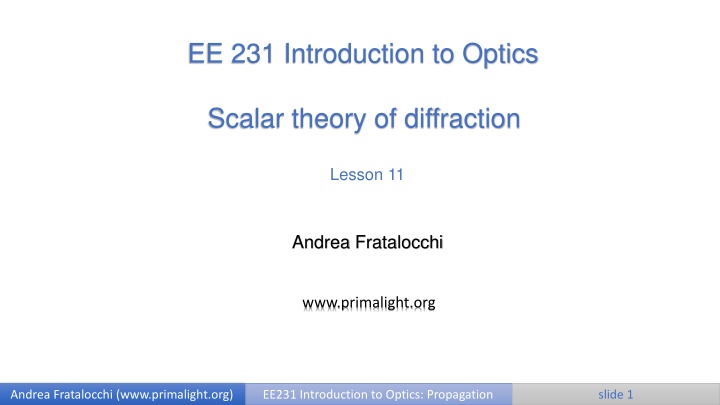
Scalar Theory of Diffraction in Optics: Understanding Gaussian Beams
Explore the scalar theory of diffraction in optics with a focus on Gaussian beams, including discussions on phase terms, power calculations, and direct vs. inverse problems. Learn from Andrea Fratalocchi's insightful EE231 Introduction to Optics slides.
Download Presentation

Please find below an Image/Link to download the presentation.
The content on the website is provided AS IS for your information and personal use only. It may not be sold, licensed, or shared on other websites without obtaining consent from the author. If you encounter any issues during the download, it is possible that the publisher has removed the file from their server.
You are allowed to download the files provided on this website for personal or commercial use, subject to the condition that they are used lawfully. All files are the property of their respective owners.
The content on the website is provided AS IS for your information and personal use only. It may not be sold, licensed, or shared on other websites without obtaining consent from the author.
E N D
Presentation Transcript
EE 231 Introduction to Optics Scalar theory of diffraction Lesson 11 Andrea Fratalocchi www.primalight.org 4/20/2025 1 Andrea Fratalocchi (www.primalight.org) EE231 Introduction to Optics: Propagation slide 1
The Scalar theory of diffraction Homework 3: what about the phase term ? The total phase of the Gaussian beam reads as follows Phase term of a plane wave Gouy phase term The Gouy term represents a phase anomaly contribution to that of a plane wave solution. In most experiment this term is unobserved as we are looking at the intensity of the field. It plays a role for high order Gaussian beams. 4/20/2025 2 Andrea Fratalocchi (www.primalight.org) EE231 Introduction to Optics: Propagation slide 2
The Scalar theory of diffraction 4/20/2025 3 Andrea Fratalocchi (www.primalight.org) EE231 Introduction to Optics: Propagation slide 3
The Scalar theory of diffraction Exercise 1: calculate the power carried by a Gaussian beam 4/20/2025 4 Andrea Fratalocchi (www.primalight.org) EE231 Introduction to Optics: Propagation slide 4
The Scalar theory of diffraction Exercise 1: calculate the power carried by a Gaussian beam From the definition of Power carried by an electromagnetic wave 4/20/2025 5 Andrea Fratalocchi (www.primalight.org) EE231 Introduction to Optics: Propagation slide 5
The Scalar theory of diffraction Exercise 1: calculate the power carried by a Gaussian beam From the definition of Power carried by an electromagnetic wave We have: 4/20/2025 6 Andrea Fratalocchi (www.primalight.org) EE231 Introduction to Optics: Propagation slide 6
The Scalar theory of diffraction Exercise 1: calculate the power carried by a Gaussian beam From the definition of Power carried by an electromagnetic wave We have: 4/20/2025 7 Andrea Fratalocchi (www.primalight.org) EE231 Introduction to Optics: Propagation slide 7
The Scalar theory of diffraction Direct and inverse problem with Gaussian beams Direct Problem: Given the smallest spot-size , calculate all the parameters of the Gaussian beam 4/20/2025 8 Andrea Fratalocchi (www.primalight.org) EE231 Introduction to Optics: Propagation slide 8
The Scalar theory of diffraction Direct and inverse problem with Gaussian beams Direct Problem: Given the smallest spot-size , calculate all the parameters of the Gaussian beam From the Rayleigh distance 4/20/2025 9 Andrea Fratalocchi (www.primalight.org) EE231 Introduction to Optics: Propagation slide 9
The Scalar theory of diffraction Direct and inverse problem with Gaussian beams Inverse problem Given And At a distance z from an arbitrary origin, calculate And the position z' of the waist. 4/20/2025 10 Andrea Fratalocchi (www.primalight.org) EE231 Introduction to Optics: Propagation slide 10
The Scalar theory of diffraction Direct and inverse problem with Gaussian beams Inverse problem Given And At a distance z from an arbitrary origin, calculate And the position z of the waist. In this case we need to solve the evolution equations for the spot-size and the curvature in terms of L and z 4/20/2025 11 Andrea Fratalocchi (www.primalight.org) EE231 Introduction to Optics: Propagation slide 11
The Scalar theory of diffraction ABCD representation of Gaussian Beams We introduce the parameter q defined as follows: At z=0 Exercise 2: propagate the beam at generic z and calculate the equivalent q parameter 4/20/2025 12 Andrea Fratalocchi (www.primalight.org) EE231 Introduction to Optics: Propagation slide 12
The Scalar theory of diffraction ABCD representation of Gaussian Beams Exactly like a translation matrix in ray optics! 4/20/2025 13 Andrea Fratalocchi (www.primalight.org) EE231 Introduction to Optics: Propagation slide 13
The Scalar theory of diffraction ABCD representation of Gaussian Beams This is a general result Optical system 4/20/2025 14 Andrea Fratalocchi (www.primalight.org) EE231 Introduction to Optics: Propagation slide 14
The Scalar theory of diffraction The interaction problem In the scalar theory of diffraction, the interaction problem is addressed by defining a ''transfer function" 4/20/2025 15 Andrea Fratalocchi (www.primalight.org) EE231 Introduction to Optics: Propagation slide 15
The Scalar theory of diffraction The interaction problem The transfer function is defined by the ratio between the output scalar field and and input field impinging the diffractive object In the scalar theory of diffraction, the interaction problem is addressed by defining a ''transfer function" 4/20/2025 16 Andrea Fratalocchi (www.primalight.org) EE231 Introduction to Optics: Propagation slide 16
The Scalar theory of diffraction The interaction problem Example: slit of width a centered at z=d If we assume that the material absorbs all impinging energy except the one passing through the slit, we have: 4/20/2025 17 Andrea Fratalocchi (www.primalight.org) EE231 Introduction to Optics: Propagation slide 17
The Scalar theory of diffraction The interaction problem Example: slit of width a centered at z=d If we assume that the material absorbs all impinging energy except the one passing through the slit, we have: Question: what are the limitations of this approach? 4/20/2025 18 Andrea Fratalocchi (www.primalight.org) EE231 Introduction to Optics: Propagation slide 18
The Scalar theory of diffraction The interaction problem Question: what are the limitations of this approach? It assumes that the response of the diffractive object does not depend on the input conditions but only on the geometry of the object. In general: 4/20/2025 19 Andrea Fratalocchi (www.primalight.org) EE231 Introduction to Optics: Propagation slide 19
The Scalar theory of diffraction The interaction problem How big is this contribution? Let us evaluate it with an example This is a classical problem in diffraction theory that can be solved exactly with no approximation 4/20/2025 20 Andrea Fratalocchi (www.primalight.org) EE231 Introduction to Optics: Propagation slide 20
The Scalar theory of diffraction The interaction problem The perfect conductor generates an oscillating field, that interferes with the impinging wave 4/20/2025 21 Andrea Fratalocchi (www.primalight.org) EE231 Introduction to Optics: Propagation slide 21
The Scalar theory of diffraction The interaction problem This contribution is small and extends for few wavelengths only. This "second " order effect is neglected in the scalar theory of diffraction and in the transfer function approach at first order. The perfect conductor generates an oscillating field, that interferes with the impinging wave 4/20/2025 22 Andrea Fratalocchi (www.primalight.org) EE231 Introduction to Optics: Propagation slide 22
The Scalar theory of diffraction The interaction problem Homework 1: calculate the transfer function of a thin lens 4/20/2025 23 Andrea Fratalocchi (www.primalight.org) EE231 Introduction to Optics: Propagation slide 23
The Scalar theory of diffraction References 1) A. Yariv, Optical electronics in modern communications, Chapter 2. 4/20/2025 24 Andrea Fratalocchi (www.primalight.org) EE231 Introduction to Optics: Propagation slide 24






















